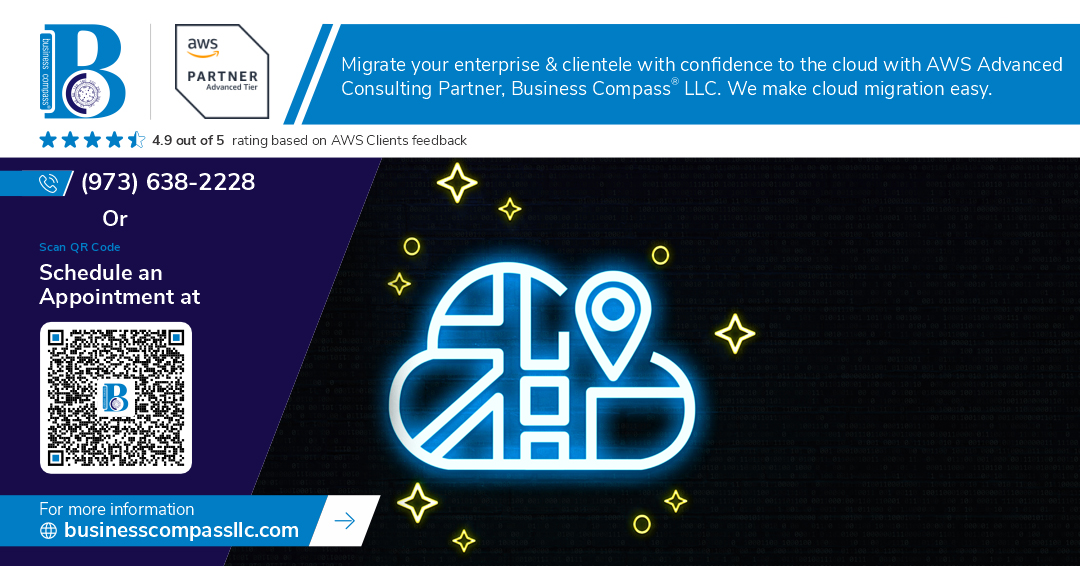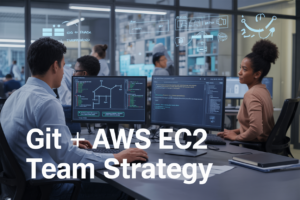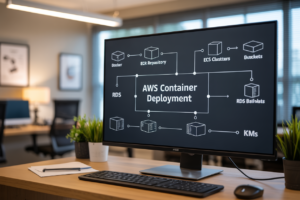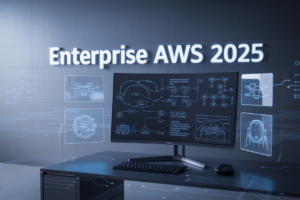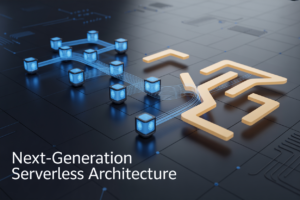🚀 Are you ready to supercharge your AWS infrastructure? Imagine seamlessly connecting your compute resources with a myriad of powerful AWS services, creating a symphony of efficiency and scalability. Whether you’re a seasoned cloud architect or just starting your AWS journey, mastering the art of integration can be the key to unlocking unprecedented potential in your applications.
In today’s fast-paced digital landscape, businesses demand more from their cloud infrastructure than ever before. The challenge lies not just in choosing the right compute service—be it EC2, Lambda, Fargate, ECS, or EKS—but in harmonizing these powerhouses with other AWS offerings. How do you ensure your EC2 instances communicate flawlessly with your RDS databases? Can Lambda functions truly revolutionize your event-driven architecture? What’s the secret to optimizing containerized workloads with Fargate?
Buckle up as we embark on an exciting exploration of AWS compute integration. From understanding the nuances of each compute service to uncovering best practices that will elevate your cloud game, this guide will equip you with the knowledge to create robust, efficient, and scalable solutions. Let’s dive into the world of EC2, Lambda, Fargate, ECS, and EKS, and discover how to weave them seamlessly into the fabric of your AWS ecosystem! 💡🔗
Understanding AWS Compute Services
A. EC2: Scalable virtual servers
Amazon Elastic Compute Cloud (EC2) is the cornerstone of AWS compute services, offering scalable virtual servers in the cloud. EC2 instances provide flexible computing capacity, allowing you to quickly scale up or down based on your application’s demands.
Key features of EC2 include:
- Multiple instance types optimized for different use cases
- On-demand, reserved, and spot pricing options
- Integration with other AWS services for enhanced functionality
B. Lambda: Serverless functions
AWS Lambda revolutionizes the way we think about computing by introducing a serverless paradigm. With Lambda, you can run code without provisioning or managing servers, paying only for the compute time consumed.
Benefits of Lambda:
- Automatic scaling and high availability
- Support for multiple programming languages
- Event-driven execution model
C. Fargate: Containerized applications
AWS Fargate is a serverless compute engine for containers that works with both Amazon Elastic Container Service (ECS) and Amazon Elastic Kubernetes Service (EKS). It eliminates the need to manage the underlying infrastructure for your containerized applications.
Fargate advantages:
- Simplified container deployment and management
- Pay-per-task model for cost efficiency
- Seamless integration with other AWS services
D. ECS: Container orchestration
Amazon Elastic Container Service (ECS) is a fully managed container orchestration service that simplifies the deployment, management, and scaling of containerized applications.
ECS features:
- Support for Docker containers
- Integration with other AWS services for networking, security, and monitoring
- Choice of EC2 or Fargate launch types
E. EKS: Managed Kubernetes
Amazon Elastic Kubernetes Service (EKS) is a managed Kubernetes service that makes it easy to run Kubernetes on AWS without the complexity of managing the control plane.
EKS benefits:
- Certified Kubernetes conformance for compatibility
- Integration with AWS networking and security services
- Support for both EC2 and Fargate compute types
| Service | Use Case | Scalability | Management Overhead |
|---|---|---|---|
| EC2 | Flexible compute | Manual/Auto scaling | High |
| Lambda | Event-driven, serverless | Automatic | Low |
| Fargate | Containerized apps | Automatic | Low |
| ECS | Container orchestration | Automatic | Medium |
| EKS | Kubernetes workloads | Automatic | Medium |
Now that we’ve explored the various AWS compute services, let’s dive into how to integrate EC2 with other AWS services to build robust and scalable applications.
Integrating EC2 with AWS Services
Connecting EC2 to RDS for database management
When integrating EC2 instances with Amazon RDS, you can create powerful and scalable database-driven applications. To establish a connection between EC2 and RDS:
- Configure security groups
- Use the RDS endpoint in your application
- Implement connection pooling
Here’s a comparison of different connection methods:
| Method | Pros | Cons |
|---|---|---|
| Direct connection | Simple setup | Limited scalability |
| Connection pooling | Improved performance | Requires additional configuration |
| Proxy service | Enhanced security | Slight latency increase |
Using S3 for EC2 data storage and backup
Amazon S3 provides a reliable and cost-effective solution for EC2 data storage and backup. Key benefits include:
- Durability: 99.999999999% object durability
- Scalability: Virtually unlimited storage capacity
- Cost-effectiveness: Pay only for what you use
To integrate EC2 with S3:
- Create an IAM role for EC2 with S3 access
- Attach the role to your EC2 instance
- Use AWS CLI or SDK to interact with S3 from your EC2 instance
Implementing CloudWatch for EC2 monitoring
CloudWatch provides comprehensive monitoring for EC2 instances, allowing you to:
- Track CPU utilization, network traffic, and disk I/O
- Set up custom metrics and alarms
- Create dashboards for visualizing performance data
To implement CloudWatch monitoring:
- Enable detailed monitoring for your EC2 instances
- Configure CloudWatch agents for more granular metrics
- Set up alarms for critical thresholds
Enhancing security with VPC and Security Groups
Protect your EC2 instances by leveraging Amazon VPC and Security Groups:
- VPC: Create isolated network environments
- Security Groups: Act as virtual firewalls for EC2 instances
Best practices for EC2 security:
- Use private subnets for sensitive resources
- Implement least privilege access with Security Groups
- Enable VPC Flow Logs for network traffic analysis
Now that we’ve covered EC2 integration, let’s explore how Lambda can be leveraged for serverless integration with AWS services.
Leveraging Lambda for Serverless Integration
Triggering Lambda functions with S3 events
Lambda functions can be seamlessly integrated with S3 events, allowing for automated processing of files as they are uploaded, modified, or deleted in your S3 buckets. This powerful combination enables real-time data processing, image resizing, and file validation workflows.
Here’s a comparison of common S3 events that can trigger Lambda functions:
| S3 Event Type | Description | Use Case |
|---|---|---|
| s3:ObjectCreated:* | Triggered when an object is created | Process new uploads |
| s3:ObjectRemoved:* | Triggered when an object is deleted | Clean up related resources |
| s3:ObjectTagging:* | Triggered when object tags are changed | Update metadata in other services |
To set up S3 event triggers for Lambda:
- Create a Lambda function
- Configure S3 event notification
- Grant necessary permissions to Lambda
Connecting Lambda to DynamoDB for data processing
Lambda and DynamoDB form a powerful serverless duo for efficient data processing. Lambda can read from and write to DynamoDB tables, enabling real-time data transformations, aggregations, and analytics.
Key benefits of this integration:
- Scalability: Both services automatically scale to handle varying workloads
- Cost-effective: Pay only for the resources you use
- Low latency: Direct integration ensures fast data processing
Using API Gateway with Lambda for RESTful APIs
Combining API Gateway with Lambda allows you to create scalable, serverless RESTful APIs. This integration provides a robust solution for building microservices and backend systems.
Steps to create a Lambda-backed API:
- Design your API in API Gateway
- Create Lambda functions for each endpoint
- Configure API Gateway to route requests to Lambda
- Deploy and test your API
Implementing SNS for Lambda notifications
Lambda can be integrated with Simple Notification Service (SNS) to send notifications based on function execution results or to trigger Lambda functions in response to SNS messages.
Use cases for Lambda-SNS integration:
- Send alerts on critical system events
- Trigger multi-step workflows
- Implement fan-out architectures for parallel processing
By leveraging these integrations, you can build powerful serverless applications that are scalable, cost-effective, and highly responsive to events across your AWS infrastructure.
Optimizing Fargate for Containerized Workloads
Integrating Fargate with ECR for container image management
AWS Fargate and Amazon Elastic Container Registry (ECR) work seamlessly together to streamline container deployment. ECR serves as a secure, scalable repository for your Docker images, while Fargate provides serverless compute for running containers.
To integrate Fargate with ECR:
- Push your container images to ECR
- Reference the ECR image in your Fargate task definition
- Deploy your Fargate tasks or services
| Benefit | Description |
|---|---|
| Security | ECR provides private repositories with encryption at rest |
| Scalability | ECR automatically scales to meet demand |
| Integration | Seamless integration with other AWS services |
Using EFS for persistent storage in Fargate tasks
Amazon Elastic File System (EFS) offers a scalable, fully managed file storage solution for Fargate tasks. This integration allows for persistent data storage across container restarts and scaling events.
Key steps for EFS integration:
- Create an EFS file system
- Configure mount targets in your VPC
- Add EFS volume to your Fargate task definition
- Mount the EFS volume in your container
Implementing CloudWatch Logs for Fargate monitoring
CloudWatch Logs integration enables comprehensive monitoring and troubleshooting for Fargate tasks. By configuring log drivers in your task definitions, you can centralize log management and gain valuable insights into your containerized applications.
Benefits of CloudWatch Logs integration:
- Real-time log streaming
- Centralized log management
- Custom metrics and alarms
- Integration with other AWS services for advanced analysis
Now that we’ve covered optimizing Fargate for containerized workloads, let’s explore how to enhance ECS with AWS services for even greater flexibility and scalability.
Enhancing ECS with AWS Services
Utilizing Route 53 for ECS service discovery
Amazon ECS can be enhanced by leveraging Route 53 for service discovery, making it easier to locate and connect to containerized applications. Route 53’s DNS-based service discovery allows ECS tasks to automatically register themselves, enabling other services to discover and communicate with them dynamically.
Key benefits of using Route 53 with ECS:
- Automatic registration and deregistration of tasks
- Improved scalability and reliability
- Simplified service-to-service communication
Here’s a comparison of service discovery methods:
| Method | Pros | Cons |
|---|---|---|
| Route 53 | Automatic, scalable, DNS-based | Requires additional configuration |
| Manual DNS | Simple setup | Not scalable, prone to errors |
| Load Balancer | Centralized management | Additional cost, complexity |
Implementing Elastic Load Balancing for ECS tasks
Elastic Load Balancing (ELB) distributes incoming traffic across multiple ECS tasks, improving application availability and fault tolerance. By integrating ELB with ECS, you can ensure smooth scaling and efficient resource utilization.
Steps to implement ELB for ECS:
- Create an Application Load Balancer
- Configure target groups
- Update ECS task definition to include container port mappings
- Create an ECS service with load balancer configuration
Using Secrets Manager for ECS task security
AWS Secrets Manager integration enhances ECS task security by securely managing and retrieving sensitive information such as database credentials, API keys, and other secrets.
Benefits of using Secrets Manager with ECS:
- Centralized secret management
- Automatic secret rotation
- Fine-grained access control
Integrating CloudFormation for ECS infrastructure as code
CloudFormation enables you to define and manage ECS infrastructure as code, promoting consistency, version control, and easier deployment. By using CloudFormation templates, you can automate the creation and management of ECS clusters, services, and related resources.
Key advantages:
- Reproducible infrastructure
- Version-controlled deployments
- Simplified resource management
Now that we’ve explored how to enhance ECS with various AWS services, let’s move on to maximizing EKS potential in the next section.
Maximizing EKS Potential
Leveraging IAM for EKS access control
Amazon EKS integrates seamlessly with AWS Identity and Access Management (IAM) to provide robust access control for your Kubernetes clusters. This integration allows you to manage permissions at both the AWS and Kubernetes levels, ensuring a secure and granular approach to access management.
Here’s a comparison of IAM roles in EKS:
| Role Type | Purpose | Scope |
|---|---|---|
| Cluster IAM Role | Manages EKS cluster resources | AWS level |
| Node IAM Role | Controls EC2 instance permissions | AWS level |
| User/Group IAM Roles | Defines user access to EKS | AWS and Kubernetes level |
To implement IAM for EKS access control:
- Create IAM roles with appropriate permissions
- Associate roles with EKS cluster and node groups
- Map IAM roles to Kubernetes RBAC
Implementing AWS App Mesh for EKS service mesh
AWS App Mesh provides a powerful service mesh solution for EKS, enabling advanced traffic management and observability. By integrating App Mesh with EKS, you can:
- Implement fine-grained routing rules
- Enhance service discovery
- Improve application resilience
To set up App Mesh with EKS:
- Install the App Mesh controller on your EKS cluster
- Define mesh resources using custom resource definitions (CRDs)
- Configure services to use App Mesh proxies
Using CloudTrail for EKS audit logging
CloudTrail integration with EKS offers comprehensive audit logging capabilities, crucial for security and compliance. This integration allows you to:
- Track API calls made to EKS
- Monitor user activities within your cluster
- Identify potential security issues
To enable CloudTrail for EKS:
- Create a trail in the CloudTrail console
- Configure the trail to log EKS events
- Set up CloudWatch Logs for centralized log management
Integrating EKS with AWS Certificate Manager for SSL/TLS
Securing communication within your EKS cluster is essential. AWS Certificate Manager (ACM) simplifies the process of obtaining and managing SSL/TLS certificates for your Kubernetes applications.
To integrate ACM with EKS:
- Request or import certificates in ACM
- Configure the ALB Ingress Controller to use ACM certificates
- Update your Kubernetes Ingress resources to specify the ACM certificate
By leveraging these integrations, you can maximize the potential of your EKS clusters, ensuring secure, observable, and well-managed Kubernetes environments on AWS.
Best Practices for AWS Compute Integration
Implementing proper IAM roles and policies
When integrating AWS compute services, implementing proper IAM roles and policies is crucial for security and efficiency. Here are key best practices:
-
Principle of Least Privilege (PoLP):
- Grant only necessary permissions
- Regularly review and revise access rights
- Use AWS-managed policies when possible
-
Use IAM roles instead of access keys:
- Automatically rotate credentials
- Eliminate the need to store sensitive information
-
Implement role-based access control (RBAC):
- Assign roles based on job functions
- Simplify permission management
| IAM Best Practice | Benefits |
|---|---|
| PoLP | Enhanced security, reduced attack surface |
| IAM roles | Improved credential management, increased security |
| RBAC | Streamlined access control, easier auditing |
Utilizing VPC for network isolation
Virtual Private Cloud (VPC) is essential for network isolation and security:
-
Implement network segmentation:
- Use subnets to separate public and private resources
- Apply Network Access Control Lists (NACLs) for subnet-level security
-
Configure VPC endpoints:
- Enable private communication with AWS services
- Reduce data transfer costs and enhance security
-
Implement VPC peering or AWS Transit Gateway:
- Connect multiple VPCs securely
- Simplify network architecture for multi-account setups
Leveraging AWS CloudFormation for infrastructure management
AWS CloudFormation enables infrastructure-as-code (IaC) for consistent and repeatable deployments:
-
Create reusable templates:
- Define infrastructure components as code
- Ensure consistency across environments
-
Use nested stacks:
- Modularize complex infrastructures
- Improve manageability and reusability
-
Implement change sets:
- Preview changes before applying
- Reduce risk of unintended modifications
Implementing proper monitoring and logging strategies
Effective monitoring and logging are crucial for maintaining and troubleshooting AWS compute integrations:
-
Utilize AWS CloudWatch:
- Set up custom metrics and alarms
- Create dashboards for visibility
-
Implement centralized logging:
- Use AWS CloudWatch Logs or third-party solutions
- Enable log retention and analysis
-
Implement distributed tracing:
- Use AWS X-Ray for request tracking
- Identify performance bottlenecks
Considering cost optimization techniques
Optimizing costs is essential for efficient AWS compute integration:
-
Right-sizing resources:
- Use AWS Cost Explorer to identify under-utilized instances
- Implement auto-scaling for dynamic workloads
-
Leverage spot instances:
- Use for non-critical, interruptible workloads
- Implement fault-tolerant architectures
-
Implement data transfer optimizations:
- Use AWS Direct Connect for high-volume data transfers
- Optimize data storage locations to reduce transfer costs
By following these best practices, you can ensure secure, efficient, and cost-effective integration of AWS compute services with other AWS offerings. These strategies will help you build robust and scalable architectures that leverage the full potential of AWS’s compute ecosystem.
AWS Compute services offer powerful solutions for diverse application needs, and their seamless integration with other AWS services enhances scalability, performance, and functionality. Whether you’re using EC2 for traditional workloads, Lambda for serverless applications, or container-based solutions like Fargate, ECS, and EKS, the ability to connect these compute resources with storage, networking, and management services creates a robust and efficient cloud ecosystem.
By following best practices and leveraging the unique strengths of each compute option, developers and organizations can build sophisticated, scalable applications that take full advantage of AWS’s extensive service offerings. As you embark on your AWS integration journey, remember that the key to success lies in choosing the right compute service for your specific use case and effectively combining it with complementary AWS services to create a tailored, high-performance solution.










